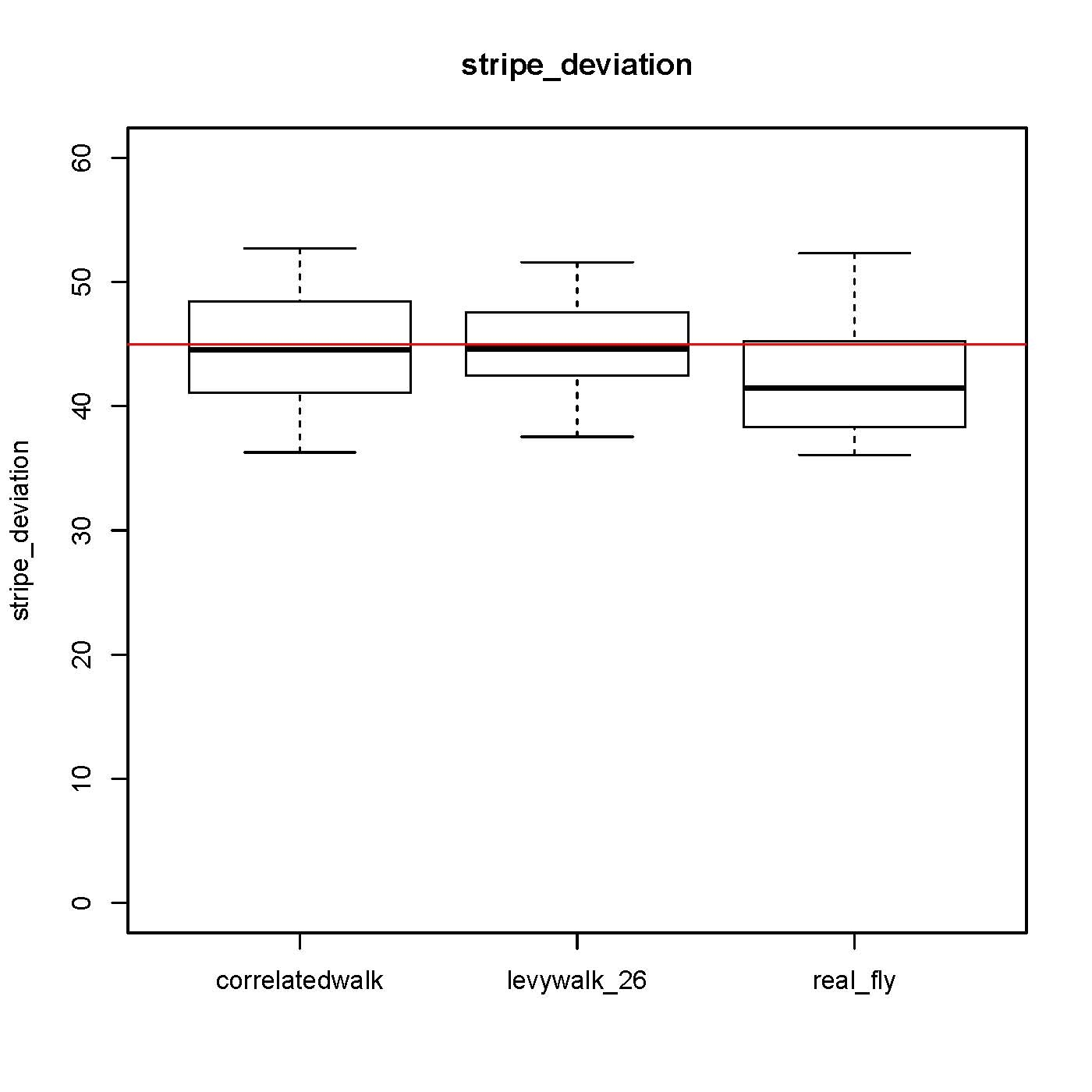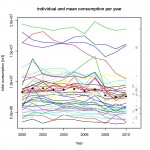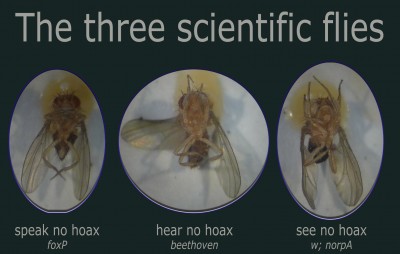I worked on CeTrAn, corrected some bugs and added boxplot visualization of each variable. As an examples see how the stripe deviation variable vary in computer generated data, quite impressive:
self-learning experiments: no phenotype with d42Gal4,chaGal80?
[pdf lab.brembs.net/wp/wp-content/uploads/2012/10/tG80_PKCi_c380G_subset.pdf 500 600]
n=6 but high self learning score for UAS-GFP; chaGal4,chaGal80 x tubGal80ts; UASPKCi (that I wanted to use as a positive control).
| Possible cause | putative solution | |
| UASPKCi flies are not clean | got new flies from the stock | |
| start new crosses to redo the line ? | ||
| will test d42Gal4 as a driver again (waiting for males) | ||
|
crosses to get d42Gal4,chaGal80ts sans la construction GFP | |
| Ask for fly and forsee new crosses for c380Gal4 | ||
| Biology | I will think about it when all other possibilities will be tested for. | |
next step is to test a real positive control again (d42Gal4 or elavGal4 if I do not have any d42Gal4 males tomorrow), along with the d42Gal4,chaGal80.
News from Neurofly
A lot of things I learned at the neurofly. First my old friend Benjamin is doing a great postdoc in Bruno van Swinderen lab. It was great to see his data on isoflurane effects and the correlation between sleep disorder and sensitivity to anesthesia.
More related to our interests, I learned that Paul Tchénio has now a prototype to visualize neuronal activity in about half of the fly brain at a decent frequency. It may be interesting to get in touch with him again.
Andre Fiala is doing/has already done the TDC-Flp construct and is using his own UAS-stop-TRPA1 line to get a subset of octopaminergic neurons. Christine will contact him soon to have more information and maybe start a collaboration with him. The student was not at his/her poster when we went there, and we could not talk directly to him/her.
I nice talk by F. Mohammad (Singapore) showed that centrophobism can be associated with anxiety: the majority of treatments used with mices (for instance immobilisation in a pipet tip) also induce more (or less for some treatments) centrophobisms in flies. I told him about the CeTrAn, he said he will look at it. (his flies were in a squared box, with their wings untouched).
Jhl21 (receptor for JH) change of larval behavior at the wandering stage (go slower and turn more): it acts at the NMJ to change the clustering of glutamate receptors. Similar thing may happen during the first hour of life of the fly, when they become phototactic ?
A nice poster from the Heisenberg’s lab show that flies do have a preferred 0 torque. Even when giving some closed loop drift, the histogram of torque suggest that the preference for the 0 torque is still there (non-uniform distribution around the +1 torque which stabilize the drift. It seems the distribution around the 0 torque is seen only if you have long enough data, I told them I would ask Satish to look at his distributions. This emphasizes why we need to be very careful in preparing the fly for our experiments…
I may have to look at the OK6 Gal4 line for motorneurons, and new RNAi lines seem to be available for PKC53e and FoxP…
I also talked to Flybase people, David was there. It seems the Buridan results should lead to 2 different entries: one linking each genotype to a dichotomic description of the phenotype (“mutant1” – “has larger”- “median_speed”) and one to the raw data and analysis. This will not be easy to automatize, but looks interesting.
I am probably forgetting a couple of things in addition to my discussion with Anette Schenk and her student Anna about FoxP..
testing buzz data
looking for a platform to share our trajectory data, I got interested in buzz data. They started a little contest, and since it seemed to be a nice way to test the functionality of the web site, I participated.
I downloaded the dataset of water consumption in Canada for the last years. The data is split by year and ward. I focused on the total water consumption and ran a little analysis.
A simple ANOVA shows that the total consumption is dependent on the year, the ward and the combination of the two (this means that the differences between years consumption is not equivalent in the distinct wards). In the visualization, one can see that the mean consumption decreased in the last three years (black dots are means of consumption for each year). In the trace for each ward, we can pick particular wards with specific results. For instance ward 11 had a huge increase in consumption in 2002; and ward 2 decrease its (relative to the other very important) consumption every year since 2002.
—–
anova results
Df Sum Sq Mean Sq F value Pr(>F) data$Year 1 6.2445e+13 6.2445e+13 110.0587 < 2.2e-16 *** data$Ward 43 5.1300e+15 1.1930e+14 210.2682 < 2.2e-16 *** data$Year:data$Ward 43 1.0535e+14 2.4500e+12 4.3181 2.399e-15 *** Residuals 396 2.2468e+14 5.6738e+11 --- Signif. codes: 0 ‘***’ 0.001 ‘**’ 0.01 ‘*’ 0.05 ‘.’ 0.1 ‘ ’ 1------
The test show that it is quite easy to take data and perform its own analysis. Buzz data is not (yet?) very good in updating data, since there is no way to directly add data (in this case, once the 2011 data come, it will be needed to download the dataset, add the new data and reupload the new dataset. Not very convenient.
buridan analysis v3.0
The new version of the analysis software is online. It should be clean and will be the version coming with the paper.
google calender in thunderbird
hi all.
There is a new feature in thunderbird that allow to use google calender efficiently.
you need to install the new thunderbird (e-mail client from mozilla), install the “provider for google calendar” add on, and the lightning add on. then see: https://wiki.mozilla.org/Calendar:Using_Lightning_with_Google_Calendars for an explanation how to enter each calender. It seems to work fine and allow copy/paste function !
flying and not flying flies
I checked the putative non-flying flies we ordered. All are normal when grown at 18°. While developing at 25°, different phenotypes can be seen:
CyK: those flies have curled wings, but can fly.
U2: those flies have curled wings, cannot fly, but still beat their wings while walking (like if they could not figure out that they cannot fly ?).
other flies show no phenotype at all.
buridan update
buridan analysis v.2.5 online:
analysis of single flies added, produce a different pdf file.
several minor changes accordingly to this analysis.
on the front of Buridan analysis
By looking at a way to simulate activity/inactivity pattern in the computer generated walk, I found this:
“Fractal time in animal behaviour: the movement activity of Drosophila” Blaine J. Cole 1993
I read it, now I need to search more in order to understand it: maybe we can find ideas to perform more analyses (or corrections to the version we have) and to get better simulated data (how to determine mu in the levy walks)
“Foraging Fruit Flies: Lagrangian and Eulerian, Descriptions of Insect Swarming”
Joseph D. Majkut
phd Thesis
mu has to be lower or equal to 3: that’s already some information!
ohh science: the closer we look, the most complex it becomes… I love it!



